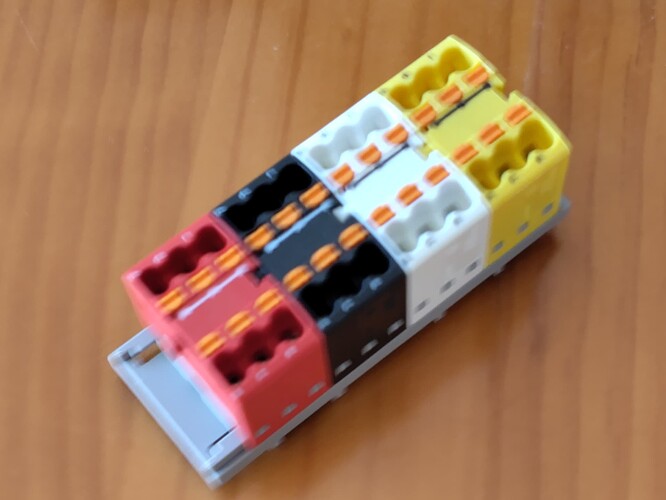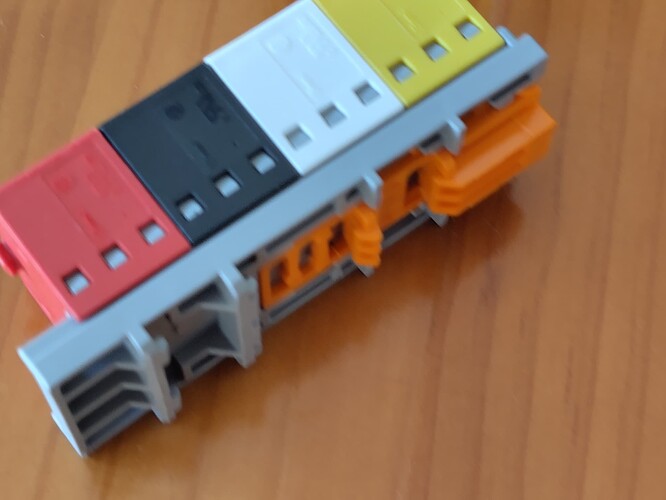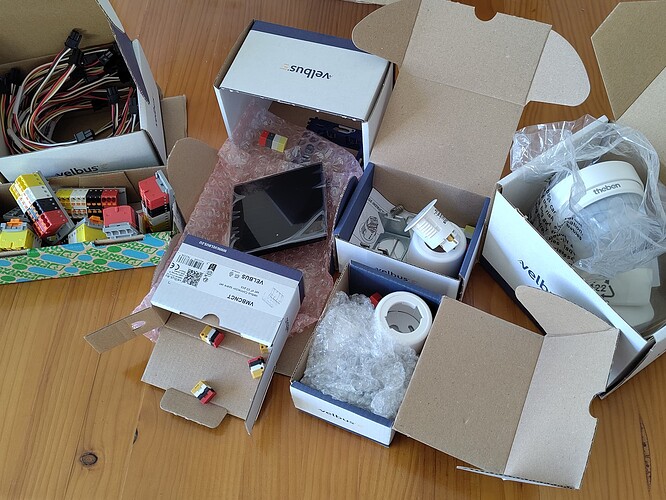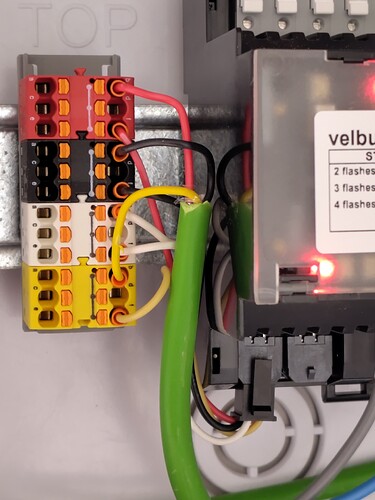Some new sweets just arrived. ![]() I’ll be testing what’s the practical distance of the RF receiver. “can I keep it somewhere in the house, or it should be close to the stuff I need to control” is the primary question. 868Mhz frequency tells me it should give a decent distance. Also I’ll convert some lights to velbus controlled vwrsion, just for the fun of it
I’ll be testing what’s the practical distance of the RF receiver. “can I keep it somewhere in the house, or it should be close to the stuff I need to control” is the primary question. 868Mhz frequency tells me it should give a decent distance. Also I’ll convert some lights to velbus controlled vwrsion, just for the fun of it ![]()
![]() Try adding an external antenna and see what you get.
Try adding an external antenna and see what you get.
I can very seriously use my keyfob from the far end of the road. Not quite while standing at the counter of the fish and chip shop… but outside it.
I have a smaller attenna than this
I did not test the range yet. Setting it up was so easy that it makes no sense to write the detailed manual. Replace battery in the fobs, connect the RF receiver, change its address, add fobs in settings, assign actions, done. I use it for internal gates, so I don’t need “a local fish and chip shop” range ![]() My concerns were around range through the walls / ceilings - absolutely no problem with that.
My concerns were around range through the walls / ceilings - absolutely no problem with that.
Relay for switching a small wall light - connected, linked with a wall controller, works.
Master and slave dimmer for controlling a LED ceiling light - connected, linked with a wall controller, works. But…the lights are blinking. A lot. With 100% it’s barely noticeable (without the dimmer was the same), but at lower levels it’s not something I can live with. I guess it might a low quality LED bulbs (I got the best I could, but I’ll keep searching) or the quality of main power supply is low. I’m quite sure the mains is the culprit, so I want to buy a voltage stabiliser to power all lights. Something small, a couple hundred watts would be fine. Any recommendations? I post it is a separate topic as well - I can’t be the only one with blinking LEDs ![]()
I can’t be the only one with blinking LEDs.
Oh my, could it be that PWM thing again? It keeps coming up all the time, everywhere. How to choose right PWM frequency for LED? - Electrical Engineering Stack Exchange has a pretty nice discussion of the problem.
But…the lights are blinking. A lot. With 100% it’s barely noticeable (without the dimmer was the same), but at lower levels it’s not something I can live with. I guess it might a low quality LED bulbs (I got the best I could, but I’ll keep searching) or the quality of main power supply is low.
What you’re seeing at 100% is most likely the blinking from the switching rectifier (AC->DC converter). It is, unfortunately, the state of art in producing some DC power, and the only thing that differs in implementations is the frequency. You will not find anything lights with linear DC output in consumer spaces. At lower dim levels PWM in the output of the dimmers… accentuate the issue.
I don’t really have any solutions, though, but am too keen to find out if there are any.
I do not know how can I change the frequency - need to do my homework. The 0 to 10C Finder slave dimmer has minimum manual. I have equipment and enough knowledge to do a detailed check outside of the bulbs (UPS for stable power supply, oscilloscope, etc.). The bulbs are without external AC/DC rectifier, so the rectifier is build in. If you’re right - I’ll be looking for new bulbs. I might even sacrifice one of the bulbs and try to check what’s inside. Also the blinking is very irregular, so I hope for mains problem, not rectifier problem.
P.S. If you have any bulbs that do not have that problem - please share brand/model. Anything with high CRI (Colour Rendering Index), might be LED or CFL
Connecting power lines to inline UPS that stabilises the voltage didn’t make any change to the blinking.
I find that
Integral
Crompton
Ansell Pro
Lamps / fitting work very well
Yes, choice of bulbs seems to make a big difference.
Has much improved in recent years though. It used to be so bad.
We have lots of Aurora mPro LED fire-safe in-ceiling lamps. They all work great. All the Aurora Enlite downlights also good.
Crompton have been fine except I have a lot of failures on the small (golf ball) ones… they start doing a slow flash on/off (5s on, 5s off) after some months, when on full brightness.
My best discovery is that all the v.cheap “LAP” branded bulbs from Screwfix work really well. I have them in table lamps, central pendants, all over the place and in a big chandlelier.
The most awkward lamps for me have been the fancy and expensive Italian designer ones that my wife found (integrated LED, not changeable). I had to swap VMBDMI-R dimmers for VMB4DC + Finder just to get these acceptable and even now they do not like low DIM settings… you can start at 100% and dim to 40% OK but if you try to go straight to 40% from off they do not light.
With the finder modules I had to try the different switch settings on the slave dimmer module to see which worked best. Different settings suit different LED bulbs. It is not so simple as trailing-edge is always good for LED bulbs.
Some kitchen under-cupboard LED strips with low-voltage/current drivers have been troublesome… I had to change drivers a few times until I find ones that work well.
G9 LED bulbs have been really difficult. I had to try lots of different ones before I found some that worked OK. The ones we settled on as best were actually quite cheap too. G4 were even more trouble as there are few choices.
I have two chandeliers that do not dim nicely… at some dim levels they flicker. So with those I try to use step-dimming. I think I prefer that anyway… a choice of 3 brightness levels is easier to set than a smooth dim using push-buttons.
I was very impressed with the dimming of the big central lamp in our utility room. Really bright, really silky-smooth dimming and great at low levels too. Then I discovered why it works so well… my wife has put 3x 100W tungsten filament bulbs in it! LOL.
I could not find any of the recommended brands in my area, so I decided to buy different types of dimmable philips E27 led bulbs and test them. Some are perfect, so far, some are not, but only one type suffers from blinking. I had to frost paint them, but that’s a small job. On a separate note: I got a cat litter box ventilation connected to velbus relay. Now I’m waiting on motion detection sensors to make it fully automatic I hope that they are sensitive enough to detect a small black ![]()
More sweets arrived. I can send detailed photos of the din rail fixing (or anything else) if needed.
Velleman shipping was so fast that I got the goodies, but I didn’t get the invoice yet ![]()
Another piece of hardware works - the motion detector controls cat toilet extract fan via velbus relay (motion triggers the fan for 30 min). It’'s so easy in VelbusLink ![]() It might be obvious for seasoned users, but for me it’s still fantastic that I can configure a piece of hardware i.e. in my living room, then take it somewhere else, plug to another part of velbus network and it will work… With the old school wiring I’d even think about it
It might be obvious for seasoned users, but for me it’s still fantastic that I can configure a piece of hardware i.e. in my living room, then take it somewhere else, plug to another part of velbus network and it will work… With the old school wiring I’d even think about it
P.S. The sensor was not tested on animals yet ![]()
![]()
Phew, so we can all still say, Not tested on animals
The solution was tested by and approved by Ninja the cat ![]() . Works like a charm!
. Works like a charm! ![]()
A new device in the system - a garden wall lamp is now controlled by VMBRYLD4. I didn’t even bother with a switch - it’s time controlled and switchable from openHAB on my mobile ![]()
The DIN rail mounted splitters (?) are class. I love them. One more lamp controlled added to the system, this time by VMB4RYNO-10
Edit: ferrules on the solid core wires are not a normal practice. Do not try it at home (but they still look better than 0.8mm2 wire in a large hole in the block) ![]()
One tiny question.
What’s your justification for putting ferrules on the solid cores of the EIB cable into the Phoenix block?
I noticed that stranded cable without ferrules deforms more when put in, in my mind that’s increasing the contact area between the core and the spring.
That was a rework - up until yesterday there was a small terminal block joining those 2 cables. No justification, but I don’t expect any problems due to contact area (very low power). It was this block: My Velbus journey - #28 by PrzemoF
With stranded cables you’re right as far as I know. A side note: I sometimes work for industrial customers that state in the specifications that using any quick cable joining methods is prohibited.
There’s an outdated reference… Nothing new there, quite literally ![]()
Another small piece automated: a chlorine peristaltic pump. Now I need to set it to run only when the main pump works - I guess the “follow” function was made for it…





